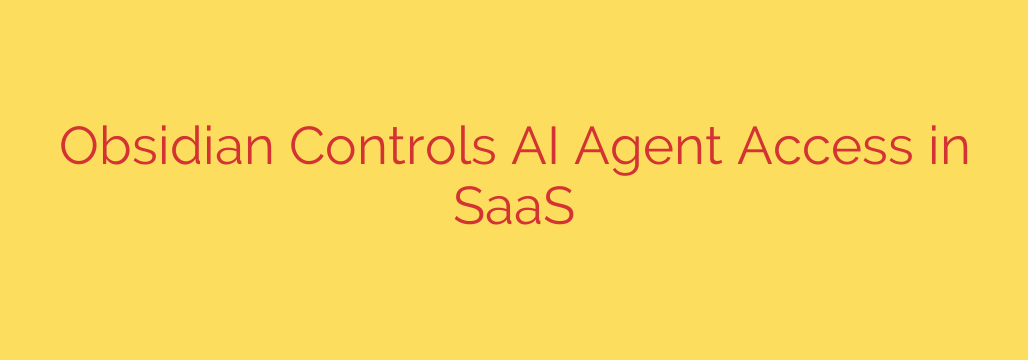
Securing the AI Revolution: A Guide to Managing AI Agent Access in SaaS
The race to integrate artificial intelligence into every facet of business is on. From automating workflows in Salesforce to generating reports in Microsoft 365, AI is unlocking unprecedented levels of productivity. However, this rapid adoption has created a new and often invisible security challenge: the rise of AI agents operating within your core SaaS applications.
While these integrations promise efficiency, they also introduce a critical security blind spot. When you connect a third-party AI model or agent to your SaaS environment, you are essentially granting it permissions to access and manipulate your company’s most sensitive data. Understanding and controlling this access is the next frontier of cybersecurity.
The New Threat Vector: Over-Privileged AI Agents
At its core, the problem lies with permissions. An AI agent connected to a platform like Microsoft 365 or Google Workspace needs specific access rights to perform its function. Often, for the sake of convenience, these agents are granted broad, user-like permissions that far exceed what is necessary.
This creates several significant risks:
- A Massive Attack Surface: Each AI integration becomes a potential entry point for attackers. If the third-party AI service is compromised, attackers could pivot into your SaaS environment using the agent’s credentials and permissions.
- Lack of Visibility: Security teams often have no clear view of which AI agents are connected to their systems, what data they are accessing, or what actions they are performing. This “shadow AI” problem makes it impossible to assess risk accurately.
- Data Exfiltration and Misuse: A poorly configured or malicious agent could be used to systematically access and exfiltrate sensitive information, from customer data and financial records to intellectual property.
- Compliance and Governance Gaps: Without proper oversight, your organization cannot ensure that AI usage complies with regulations like GDPR, CCPA, or industry-specific data handling requirements.
Traditional security tools are not equipped to handle this new challenge. They are designed to monitor human users, not the autonomous, high-velocity actions of AI agents. This leaves a dangerous gap in an organization’s security posture.
A Proactive Framework for AI Security in SaaS
To effectively mitigate the risks posed by AI agents, security and IT leaders must adopt a new approach focused on visibility, governance, and threat detection. The goal is to enable the business to innovate with AI safely, not to block it.
The solution involves a multi-layered strategy:
Comprehensive Discovery: The first step is always visibility. You cannot protect what you cannot see. It is crucial to have a system in place that can automatically discover and inventory every third-party AI integration across your entire SaaS ecosystem. This includes identifying which users authorized them and when they were connected.
In-Depth Permission Analysis: Once an agent is identified, you must understand exactly what it is authorized to do. This means analyzing its permissions to see if it can read emails, modify files, delete records, or access sensitive APIs. This analysis provides the context needed to assess the potential blast radius of a compromised agent.
Enforcing the Principle of Least Privilege: Most AI agents are vastly over-privileged. The core of effective AI governance is applying the principle of least privilege, ensuring the agent has only the absolute minimum permissions required for its designated task. If an AI tool only needs to read calendar data, it should not have the ability to modify contacts or send emails.
Continuous Activity Monitoring: Security is not a one-time setup. It requires continuous monitoring of AI agent activity to detect anomalous or malicious behavior. This includes flagging unusual data access patterns, actions performed outside of normal business hours, or attempts to escalate privileges, which could all indicate a compromise.
Actionable Steps to Secure Your AI Integrations
Securing your SaaS environment from AI-related threats requires immediate and deliberate action. Here are practical steps your organization can take today:
- Conduct an Audit: Manually or with specialized tools, perform a complete audit of all third-party applications and AI agents connected to your critical SaaS platforms.
- Establish a Governance Policy: Create clear policies for the procurement, approval, and integration of new AI tools. Ensure that security teams are involved in the review process from the beginning.
- Review and Right-Size Permissions: For every existing AI integration, review its permissions and revoke any that are not strictly necessary. Work with business units to understand the required functionality and enforce least-privilege access.
- Leverage Modern Security Platforms: Invest in a SaaS Security Posture Management (SSPM) solution that is specifically designed to discover, monitor, and control AI agent access. These platforms provide the necessary visibility and automation to manage AI risk at scale.
As AI becomes more deeply embedded in business operations, the security of the agents that power it will become paramount. By taking a proactive approach focused on visibility and control, organizations can harness the power of AI without exposing themselves to unacceptable risk.
Source: https://www.helpnetsecurity.com/2025/09/23/obsidian-ai-agents-saas-environments/








